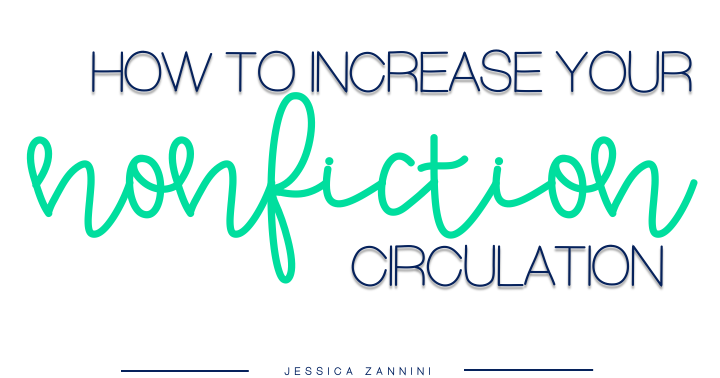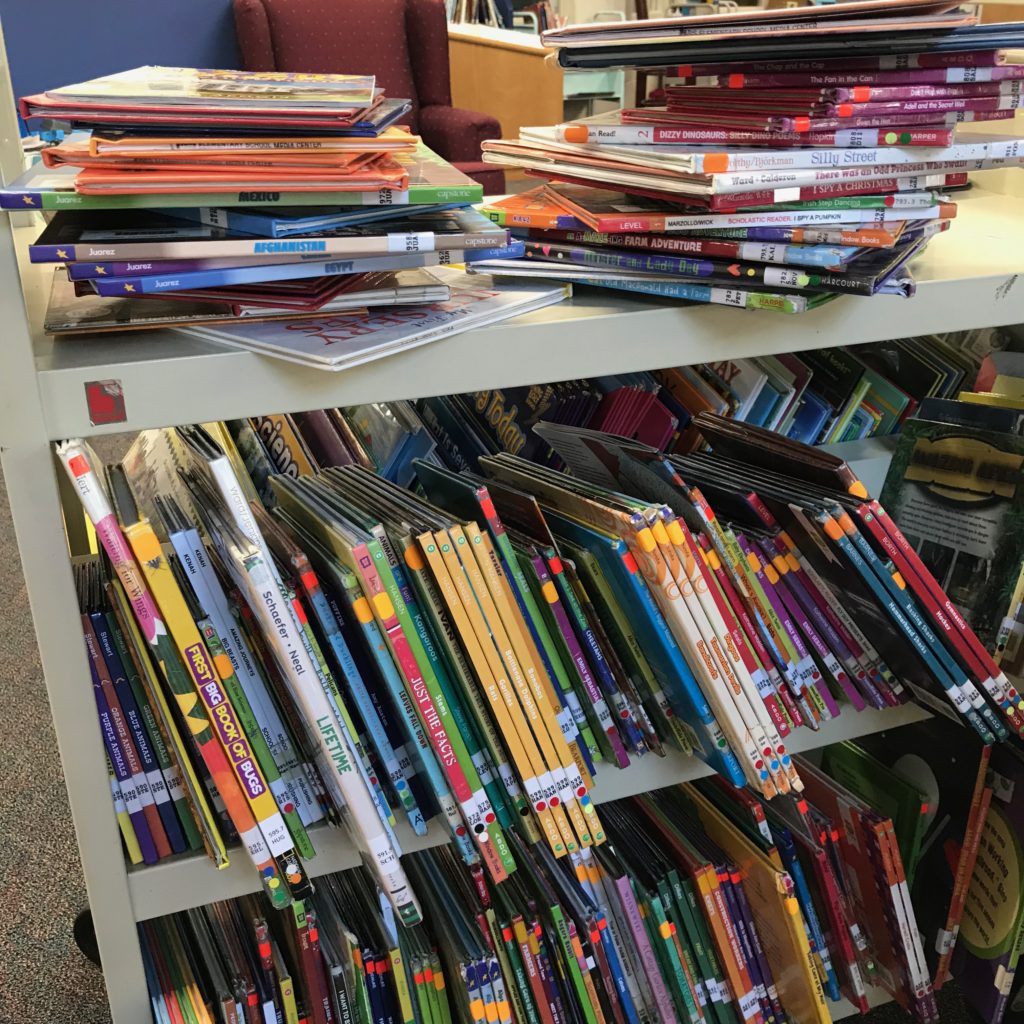
Some school libraries are moving away from the Dewey Decimal System into other ways of categorizing books. This often leads to an increase nonfiction circulation because students are finding the books they want to read.
Organizing the Nonfiction in an Elementary School Library to Increase Nonfiction Circulation
The big question is, will this help students when they move on from the school library into a more universal library?
The elementary school library is a challenging place. You have community members who are learning to read AND members who are reading to learn.
The ultimate goal is to help readers find the books they need and want.
In hopes for allowing readers (both emerging and those who are able to read) to find books, we divided the nonfiction section into two parts. All nonfiction books with a 2.0 reading level or lower are being moved into an Everybody Nonfiction Section. This is located right next to the Everybody Fiction section which has fiction picture books.
The other nonfiction books will stay in the original nonfiction section and stay organized by the Dewey Decimal System.

The Problem
Younger students have difficulty finding high interest informational books in the nonfiction section of the library. This is due to the fact that most are just learning to read letters and numbers, making the Dewey Decimal System even harder to learn. (Daigle, N., Summer, J., Perry, A., Colvin, S., 2015) This makes it difficult for younger students to find the books they want. If they do not have a librarian, clerk, or teacher to help them, they are often lost in this section of the library.
Ideally, these students could ask the school library media specialist for assistance. The school librarian is often teaching a class when students come for individual check out. Students need to be able to independently find high interest books on the shelves.
When a student is browsing for something that may peak his or her interest they often come up against a time constraint before they have found that “just right book.”
The lack of browsability in the Dewey nonfiction section of the library leads to an underutilization of the collection when it comes to informational titles.
The Dewey Organized Section
Even with displaying titles, this section was overwhelming for young readers. They could not read the spines and many of their choices were ones that were difficult to read and comprehend. They got very frustrated when there was no one to help them.
The librarian and clerk try to help everyone, but with an entire class checking out and students coming in for individual checkout, it became difficult to help every student in a 15 minute time period to find the books they desired.
Solution
We divided the nonfiction section into two sections. The current Nonfiction continues to follow the Dewey Decimal System. Leaving this section of the library in the Dewey organization, allows for the older students to learn how to use the majority of libraries in their current and future communities.
With older students having an understanding of larger numbers and comparing and ordering numbers, plus an understanding of ABC order, they are more successful in the Dewey organization.
Nonfiction books on a second grade reading level or lower were moved to a new Everybody Nonfiction section. This section is located beside the Everybody Fiction allowing for the PreK-1st grade students to easily access these books. The current nonfiction section has taller shelves that are harder for younger students to reach. This new Everybody Nonfiction section is on shorter shelves that allowing for all students to easily access the books.


This new section is organized into a Dewey-less reorganization. This reorganization has student-friendly categories. The main focus of the reorganization will be browsability and flexibility. Some examples of categories are Dinosaurs, Wild Animals, Ocean Animals, Solar System and Rocks section. Categories are labeled with child appropriate language and visuals (Kaplan, T.B., Dolloff, A.K., Giffard, S., & Still-Schiff, J., 2012).

Implementation of this solution requires a four step process:
1. Review: We started with a review of all nonfiction titles in the collection This review included knowledge of reading levels and student interests.
2. Create: The librarian created new categories for the titles moved to the Everybody Nonfiction Section. For those books that did not fit in a specific category, the librarian asked 4 to 5 students where they thought the book belonged (Kaplan, T.B., Dolloff, A.K., Giffard, S., & Still-Schiff, J., 2012). This helped to identify patron patterns of seeking information. Categories promote browsing.
3. Move: Once categories had been determined and the layout was established, all nonfiction titles with a reading level of 2.0 or lower were removed from the shelves and placed into their new categories. New spines were added to show that the book was located now in the Everybody Nonfiction (ENF).
4. Educate: The school librarian then offered a variety of ways for both students and teachers to learn about the new ‘Dewey-less’ organization system.
- Videos were created showcasing the browsability of the new nonfiction categories and were aired during the morning news show.
- The school librarian held whole class orientation sessions explaining the new organization system.
- The school librarian presented the new system during a school faculty meeting and answered any questions from teachers and administrators.
Concerns
There are concerns about students as future learners if they do not learn how to use the Dewey Decimal System. While we do not know what the future organization of libraries will hold, we do know that most at this time still follow this organization. It is important that students are able to find what they need at this stage in life, while preparing them for their futures in creating knowledge in other libraries. As Gordon states, “While user-driven collection management seems appropriate for younger library users, students need to know how to retrieve information from traditional libraries” (Gordon, 2013).

When will students learn the Dewey Decimal System?
- Students will begin learning the Dewey Decimal System in 2nd grade. One of the first units for 2nd grade is a library journey where the students learn how to find books in each section of the library.
References:
Kaplan, T.B., Dolloff, A.K., Giffard, S., & Still-Schiff, J. (2012, September 28) Are Dewey’s days numbered?: Libraries nationwide are ditching the old classification system. School Library Journal. Retrieved from https://bes.garfk12.org/wp-content/uploads/2019/02/Are-Deweys-Days-Numbered.pdf
Krashen, S. (2004) Power of reading. Portsmouth, NH: Heinemann.
Gordon, C. A. (2013). Dewey Do Dewey Don’t: A Sign of the Times. Knowledge Quest. 42(2). E1-E8.
Fox, J. (2017, July 9). School Libraries Take Cues from Bookstores to Foster Browsing, Stimulate Learning. Boston Globe. Retrieved from
Staff. (2012). To Dewey or Not to Dewey – Notes to Take Away. Retrieved from https://library.sd.gov/LIB/DEV/training/2012/SDSL2012-RethinkingTheCallNumber.pdf
Staff. (2013). Why I Won’t Ditch Dewey. The Elementary Librarian Blog. Retrieved from https://elementarylibrarian.com/why-i-wont-ditch-dewey/
Daigle, N., Summer, J., Perry, A., Colvin, S. (2015). Ditching Dewey. The Vermont Library Conference. Retrieved from https://www.vermontlibraries.org/wp/wp-content/uploads/2015/05/Ditching-Dewey-VLC-presentation.pdf
Call, A. (2016, September 7). Sorry, Dewey, the Decimals are Outdated: The Libraries of the Future Will Aid Indies. Forward Reviews. Retrieved from https://www.forewordreviews.com/articles/article/sorry-dewey-the-decimals-are-outdated-the-catalog-of-the-future-will-aid-indies/
Davis, S. (2015, May 16). Deweyless, No Regrets Living Without Dewey. Indiana State Library. Retrieved from https://continuinged.isl.in.gov/deweyless-no-regrets-living-without-dewey-1-leu/
Leave a Reply